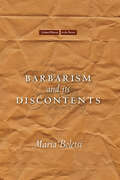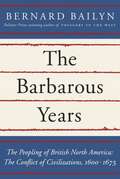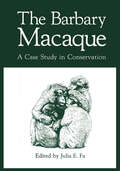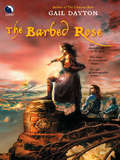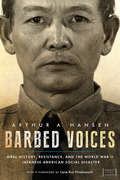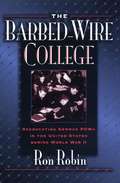- Table View
- List View
Barbarism and Its Discontents (Cultural Memory in the Present #440)
by Maria BoletsiBarbarism and civilization form one of the oldest and most rigid oppositions in Western history. According to this dichotomy, barbarism functions as the negative standard through which "civilization" fosters its self-definition and superiority by labeling others "barbarians." Since the 1990s, and especially since 9/11, these terms have become increasingly popular in Western political and cultural rhetoric—a rhetoric that divides the world into forces of good and evil. This study intervenes in this recent trend and interrogates contemporary and historical uses of barbarism, arguing that barbarism also has a disruptive, insurgent potential. Boletsi recasts barbarism as a productive concept, finding that it is a common thread in works of literature, art, and theory. By dislodging barbarism from its conventional contexts, this book reclaims barbarism's edge and proposes it as a useful theoretical tool.
The Barbarism of Berlin: Revised Edition Of Original Version (The World At War)
by G. K. ChestertonGilbert Keith Chesterton,(29 May 1874 – 14 June 1936) better known as G. K. Chesterton, was an eng writer, lay theologian, poet, philosopher, dramatist, journalist, orator, literary and art critic, biographer, and Christian apologist. Chesterton is often referred to as the "prince of paradox." Time magazine, in a review of a biography of Chesterton, observed of his writing style: "Whenever possible Chesterton made his points with popular sayings, proverbs, allegories—first carefully turning them inside out." G.K. Chesterton's The Barbarism of Berlin is a lengthy essay defending the decision by the U.K. to join World War I and fight the Central Powers, gery in particular. (Excerpt from Wikipedia)
Barbarossa: And the Bloodiest War in History
by Stewart BinnsDrawing on remarkable and never-before-seen material, the extraordinary story of one of the most horrific and devastating encounters of the Second World War.On June 22nd, 1941 the largest military invasion in human history was launched - an attack on the Soviet Union by almost four million men of Nazi Germany's brutal war machine.Operation Barbarossa led to the bloodiest military campaign mankind has ever known. The statistics of death and destruction are almost impossible to believe. The cruelty, suffering and destitution it wrought are unimaginable . . . over forty million people lost their lives.Yet, the real story of the Eastern Front is still not truly understood outside of Germany and Eastern Europe. Little is known of those who suffered in the horror of Hitler's 'War of Annihilation' - the soldiers and civilians of Eastern Europe who fought and died trying to save their homelands and their loved ones.In Barbarossa, Stewart Binns tells the story of how they lived and survived, and how, once the tide had turned, they exacted an appalling revenge on the Nazi aggressors. This is the story of the bloodiest war in history.'This is a truly astounding book, packed with searing hitherto-unpublished testimony about what it was like to endure, and ultimately defeat, the most formidable invasion in the history of Mankind.' - Andrew Roberts, author of CHURCHILL: WALKING WITH DESTINY'A masterful narrative, deeply enriched by extraordinary research and a profound analysis of the soul of Russia.' - Nick Hewer
Barbarossa: The Russian German Conflict (Sven Hassel War Classics)
by Alan ClarkThe classic account of the war on the Eastern Front between the Russians and the Germans - the greatest clash of arms the world has ever seen.Carefully researched and beautifully written, this book is a classic of military history. Alan Clark vividly narrates the course of the dramatic and brutal war between the German and Russians on the Eastern Front during the Second World War. From the invasion of Russia mounted on Midsummer's Day 1941 and the German Army's advance to the outskirts of Moscow, to the terrible turning point of Stalingrad and the eventual defeat of the Nazis at the Fall of Berlin after the hard years of fighting and advance by the Red Army, this is epic history narrated by a master.
Barbarossa: How Hitler Lost the War
by Jonathan Dimbleby'With his customary literary flair and capacity to master and mobilize very many and varied sources, Jonathan Dimbleby gives us the best single-volume account of the Barbarossa campaign to date' Andrew Roberts, author of Churchill: Walking with Destiny'Like a fast-moving juggernaut of horror, Dimbleby's Barbarossa is a page-turning descent into Hell and back. Part warning, part fable, but all too true, this fresh and compelling account of Hitler's failed invasion of the Soviet Union should be on everyone's reading list for 2021' Dr Amanda Foreman, author of A World on Fire_______________________________Operation Barbarossa, Hitler's invasion of Russia in June 1941, aimed at nothing less than a war of extermination to annihilate Soviet communism, liquidate the Jews and create Lebensraum for the German master race. But it led to the destruction of the Third Reich, and was cataclysmic for Germany with millions of men killed, wounded or registered as missing in action. It was this colossal mistake -- rather than any action in Western Europe -- that lost Hitler the Second World War.Drawing on hitherto unseen archival material, including previously untranslated Russian sources, Jonathan Dimbleby puts Barbarossa in its proper place in history for the first time. From its origins in the ashes of the First World War to its impact on post-war Europe, and covering the military, political and diplomatic story from all sides, he paints a full and vivid picture of this monumental campaign whose full nature and impact has remained unexplored.At the heart of the narrative, written in Dimbleby's usual gripping style, are compelling descriptions of the leaders who made the crucial decisions, of the men and women who fought on the front lines, of the soldiers who committed heinous crimes on an unparalleled scale and of those who were killed when the Holocaust began. Hitler's fatal gamble had the most terrifying of consequences.Written with authority and humanity, Barbarossa is a masterwork that transforms our understanding of the Second World War and of the twentieth century._______________________________'Superb. . . stays with you long after you have finished' Henry Hemming, bestselling author of Our Man in New York'A chilling account of war at its worst' Bear Grylls
Barbarossa 1941: An Atlas of German Army Situation Maps
by Mr Kevin BoylanFeaturing original 1: 2,500,000-scale German military maps, this is a beautifully presented atlas of the 1941 Operation Barbarossa campaign.Operation Barbarossa, Germany's surprise assault on the Soviet Union in June 1941, aimed at nothing less than the complete destruction of Communist Russia in a matter of months. It was the one period when the Germans had a chance of achieving victory – but the events of the campaign ultimately reversed the fortunes of the Third Reich. This atlas uses the contemporary daily situation maps produced by the German Army's General Staff to provide a clear historical and geographical picture of one of the pivotal campaigns of World War II. These maps show the configuration of the front line and the locations of major Axis combat formations, as well as the deployments and movements of Soviet combat units as the German military intelligence understood them. The maps are supported by a detailed commentary summarizing and analyzing the operations depicted, tracing the day-to-day progress of the fighting on the Eastern Front.
Barbarossa 1941: An Atlas of German Army Situation Maps
by Mr Kevin BoylanFeaturing original 1: 2,500,000-scale German military maps, this is a beautifully presented atlas of the 1941 Operation Barbarossa campaign.Operation Barbarossa, Germany's surprise assault on the Soviet Union in June 1941, aimed at nothing less than the complete destruction of Communist Russia in a matter of months. It was the one period when the Germans had a chance of achieving victory – but the events of the campaign ultimately reversed the fortunes of the Third Reich. This atlas uses the contemporary daily situation maps produced by the German Army's General Staff to provide a clear historical and geographical picture of one of the pivotal campaigns of World War II. These maps show the configuration of the front line and the locations of major Axis combat formations, as well as the deployments and movements of Soviet combat units as the German military intelligence understood them. The maps are supported by a detailed commentary summarizing and analyzing the operations depicted, tracing the day-to-day progress of the fighting on the Eastern Front.
The Barbarous Years (PDF): The Peopling Of British North America - The Conflict Of Civilizations, 1600-1675
by Bernard BailynBernard Bailyn gives us a compelling account of the first great transit of people from Britain, Europe, and Africa to British North America, their involvements with each other, and their struggles with the indigenous peoples of the eastern seaboard.
The Barbary Macaque: A Case Study in Conservation (Contributions To Primatology Ser. #Vol. 23)
by John E. FaThe Barbary macaque (all too often mistakenly called an ape) was first brought to the attention of the Conservation Working Party of the Primate Society of Great Britain late 1979 when John Fa reported that 'surplus' animals were being sent from Gibraltar to dubious locations, such as an Italian safari park. Since there had been no scientific input into the Army's management of the monkey colony on Gibraltar, and there was concern about inbreeding, nutrition and health - about the long-term viability of the colony, it was felt that the Society could help. The Gibraltar Scientific Authority and the Army were very receptive to our offer and ideas, and this topic occupied successive chairmen over the last few years - Robin Dunbar and Richard Wrangham, myself and now Miranda Stevenson - with constant prompting and help from John Fa. Considerations soon extended to the status of the species as a whole, so that there have been three main aspects:- (1) the improved health of a larger self-sustaining population on Gibraltar, (2) the status and behavioural biology of natural populations in North Africa (Morocco and Algeria), and (3) the breeding achievements in European parks and zoos, and their potential for reintroduction to suitable areas in North Africa, along with other possibilities. Robin Dunbar organized the compilation of recommendations for managing the Gibraltar colony with regard to numbers, age-sex struc ture and behavioural relationships, with some observations on diet to avoid obesity and infertility.
Barbary Pirate: The Life and Crimes of John Ward (History Press Ser.)
by Greg BakIn 1603 John Ward led a mass desertion from the English navy, stole a ship and defected to the Ottoman Empire's outpost at Tunis. Allied with the pasha, Ward led Muslim soldiers and sailors in devastating attacks against Christian shipping. Wealthy as a lord, Ward purchased a palatial mansion in Tunis and presided over a scruffy band of English and European renegades. But Ward could not purchase a return to England. When his offers to trade gold for a pardon were rejected by the king, he converted to Islam and settled in Tunis, scandalising Christians throughout Europe. Ward became infamous as the admiral of a fleet of English ships sailing under the Ottoman crescent, and for schooling Muslims in English sailing and gunnery. Was John Ward a traitor, or did England betray him? Barbary Pirate charts treacherous waters of personal honour, international intrigue and national aspiration, even while recounting the daring exploits and seaborne battles that secured his fame.The Good Book Guide. An interesting account, well presented for the general reader The Independent on Sunday
The Barbary Pirates 15th-17th Centuries (Elite)
by Gerry Embleton Angus KonstamFor the best part of three centuries the 'corsairs' or pirates from the 'Barbary' coasts of North Africa dominated the Western and Central Mediterranean. They made forays far into the Atlantic, preying on the shipping and coastal settlements across Christian Europe, ranging from Greece to West Africa and the British Isles. In the absence of organized European navies they seldom faced serious opposition, and the scope of their raiding was remarkable. As well as piracy and slave-raiding they fought as privateers, sharing their spoils with the rulers of the port-cities that provided them with ships, men, and a ready market. This book examines their development and their style of fighting, chronicles their achievements and failures, and illustrates their appearance and that of their ships, explaining why they were so feared and effective.
The Barbary Pirates 15th-17th Centuries (Elite #213)
by Angus KonstamFor the best part of three centuries the 'corsairs' or pirates from the 'Barbary' coasts of North Africa dominated the Western and Central Mediterranean. They made forays far into the Atlantic, preying on the shipping and coastal settlements across Christian Europe, ranging from Greece to West Africa and the British Isles. In the absence of organized European navies they seldom faced serious opposition, and the scope of their raiding was remarkable. As well as piracy and slave-raiding they fought as privateers, sharing their spoils with the rulers of the port-cities that provided them with ships, men, and a ready market. This book examines their development and their style of fighting, chronicles their achievements and failures, and illustrates their appearance and that of their ships, explaining why they were so feared and effective.
The Barbecue
by Alex HamiltonA brand-new approach to barbecuing with over 80 creative, contemporary and delicious recipes to try!
The Barbecue! Bible: More than 500 Great Grilling Recipes from Around the World (Steven Raichlen Barbecue Bible Cookbooks)
by Steven RaichlenThe biggest, baddest, best salute to our passion for barbecue, in glorious full-color, from &“America&’s master griller&” (Esquire). A 500-recipe celebration of sizzle and smoke, Steven Raichlen&’s award-winning The Barbecue! Bible unlocks the secrets of live-fire cooking with top dishes, the tastiest sauces, and insider techniques and tips. It&’s got everything: how to grill the perfect T-bone. Succulent chicken from around the world: Jamaica, Senegal, Brazil, India, Thailand, Uruguay. A perfect meeting of fire and ice: Fire-Roasted Banana Splits. Includes FAQs, problem-solving tips, and comprehensive notes on equipment, ingredients, marinades, rubs—even a chapter on thirst-quenchers to serve while you&’re busy fanning the coals.
Barbecue Sauces, Rubs, and Marinades--Bastes, Butters & Glazes, Too (Steven Raichlen Barbecue Bible Cookbooks)
by Steven RaichlenEvery griller's secret weapon! Transform meats and seafood, vegetables and desserts into world-class barbecue with the flavor foundations, wet and dry, that give grilled food its character, personality, depth, and soul. Chile-fired rubs, citrusy marinades, buttery bastes, pack-a-wallop sauces, plus mops. slaters, sambals, and chutneys—this cornucopia of more than 200 recipes draws on irresistible Thai, Mexican, Indian, Cajun, Jamaican, Italian, and French cuisines, plus those big flavor building blocks from America's barbecue belt. Barbecue Hall of Famer Steven Raichlen shows how to add the expert touch to every dish in your repertoire, from transforming a simple steak to electrifying an exotic kebab. Includes a step-by-step guide to building a signature barbecue sauce and recipes for more than 30 outrageous main dishes.
Barbecues: Over 200 Great Recipes
by HamlynEveryone loves barbecues - the sun, the smells, the smiles - however most of us would admit that we have a limited range when it comes to producing flame-grilled food. This book gives you over 200 tasty recipes to turn your barbecue into a barbie banquet! From quick and easy classics including Greek-style Lamb Burger and Coconut Butterfly Prawns to more meaty masterpieces such as Balsamic Steaks with Basil Mash and Tandoori Chicken, Barbecues' huge selection ensures that your barbie need never be boring again. There are also recipes for salads, desserts and drinks to make your barbecue complete.
The Barbed Coil
by J. V. JonesWhen Izgard of Garizon put on the Coil and crowned himself King, he set in train a course of tumultuous events that would reverberate around the continent. For the Coil must have blood. And the first blood to flow is that of Berick of Thorn, the legendary conqueror of Garizon. His son, Camron, wants revenge and knows that Izgard can only be stopped by force of arms. He seeks out the man who knows most about Izgard's murderous hordes - Lord Ravis, a ruthless mercenary with a dark and secret past. And Tessa McCamfrey is about to become caught up in this dangerous and exotic world - with the piratical Ravis, a beautifully patterned gold ring and a role to play in the momentous events that unfold.Look out for more information about this and other titles on the Orbit website at www.orbitbooks.co.uk
The Barbed Rose (The One Rose #2)
by Gail DaytonDemons are coming. One woman has been chosen to face them….
Barbed Voices: Oral History, Resistance, and the World War II Japanese American Social Disaster (Nikkei in the Americas)
by Arthur A. HansenBarbed Voices is an engaging anthology of the most significant published articles written by the well-known and highly respected historian of Japanese American history Arthur Hansen, updated and annotated for contemporary context. Featuring selected inmates and camp groups who spearheaded resistance movements in the ten War Relocation Authority–administered compounds in the United States during World War II, Hansen’s writing provides a basis for understanding why, when, where, and how some of the 120,000 incarcerated Japanese Americans opposed the threats to themselves, their families, their reference groups, and their racial-ethnic community. What historically was benignly termed the “Japanese American Evacuation” was in fact a social disaster, which, unlike a natural disaster, is man-made. Examining the emotional implications of targeted systemic incarceration, Hansen highlights the psychological traumas that transformed Japanese American identity and culture for generations after the war. While many accounts of Japanese American incarceration rely heavily on government documents and analytic texts, Hansen’s focus on first-person Nikkei testimonies gathered through powerful oral history interviews gives expression to the resistance to this social disaster. Analyzing the evolving historical memory of the effects of wartime incarceration, Barbed Voices presents a new scholarly framework of enduring value. It will be of interest to students and scholars of oral history, US history, public history, and ethnic studies as well as the general public interested in the WWII experience and civil rights.
Barbed Wire: Capitalism and the Enclosure of the Commons
by Patrick BrantlingerA call to transform the way we think about property, this book examines how capitalism has from its origins sought to enclose or privatize the commons, or land and other forms of property that had been viewed as communally owned, and argues that neoliberal economic policies and the corporate takeovers of urban spaces, prisons, schools, the mass media, farms, and natural resources have failed to serve the public interest. A study of corporate globalization and the continuation of empire after the era of political decolonization, it begins with the fencing of the West starting in the 1870s, and moves to examine recent phenomena such as urbanization, mass incarceration, financialization, and the treatment of people as commodities in the context of the longue durée of land enclosures, empire, and capitalism. Highlighting the threatened elimination of the public domain as a result of corporate efforts to privatize public utilities, prisons, schools, forests, seeds, and just about everything else that can yield a profit, Barbed Wire: Capitalism and the Enclosure of the Commons asks what it would mean if, instead of either private or public property, our most fundamental conception of property were communal. Would a redefinition of property from a community perspective lead us beyond the military-industrial complex?
Barbed Wire: Capitalism and the Enclosure of the Commons
by Patrick BrantlingerA call to transform the way we think about property, this book examines how capitalism has from its origins sought to enclose or privatize the commons, or land and other forms of property that had been viewed as communally owned, and argues that neoliberal economic policies and the corporate takeovers of urban spaces, prisons, schools, the mass media, farms, and natural resources have failed to serve the public interest. A study of corporate globalization and the continuation of empire after the era of political decolonization, it begins with the fencing of the West starting in the 1870s, and moves to examine recent phenomena such as urbanization, mass incarceration, financialization, and the treatment of people as commodities in the context of the longue durée of land enclosures, empire, and capitalism. Highlighting the threatened elimination of the public domain as a result of corporate efforts to privatize public utilities, prisons, schools, forests, seeds, and just about everything else that can yield a profit, Barbed Wire: Capitalism and the Enclosure of the Commons asks what it would mean if, instead of either private or public property, our most fundamental conception of property were communal. Would a redefinition of property from a community perspective lead us beyond the military-industrial complex?
Barbed Wire: Borders and Partitions in South Asia
by Jayita SenguptaThe book is an anthology of creative and critical responses to the many partitions of India within and across borders. By widening and reframing the question of partition in the subcontinent from one event in 1947 to a larger series of partitions, the book presents a deeper perspective both on the concept of partition in understanding South Asia, and understanding the implications from survivors, victims and others. The imagery of the barbed wire in the title is used precisely to confront the jaggedness of experiencing and surviving partition that still haunts the national, literary, religious and political matrices of India. The volume is a compilation of short stories, poems, articles, news reports and memoirs, with each contributor bringing forth their perception of partition and its effects on their life and identity. The many narratives amplify the human cost of partitions, examining the complexities of a bruised nation at the social, psychological and religious levels of consciousness. The book will appeal to anyone interested in literary studies, history, politics, sociology, cultural studies, and comparative literature.
Barbed Wire: Borders and Partitions in South Asia
by Jayita SenguptaThe book is an anthology of creative and critical responses to the many partitions of India within and across borders. By widening and reframing the question of partition in the subcontinent from one event in 1947 to a larger series of partitions, the book presents a deeper perspective both on the concept of partition in understanding South Asia, and understanding the implications from survivors, victims and others. The imagery of the barbed wire in the title is used precisely to confront the jaggedness of experiencing and surviving partition that still haunts the national, literary, religious and political matrices of India. The volume is a compilation of short stories, poems, articles, news reports and memoirs, with each contributor bringing forth their perception of partition and its effects on their life and identity. The many narratives amplify the human cost of partitions, examining the complexities of a bruised nation at the social, psychological and religious levels of consciousness. The book will appeal to anyone interested in literary studies, history, politics, sociology, cultural studies, and comparative literature.
The Barbed-Wire College: Reeducating German POWs in the United States During World War II
by Ron Theodore RobinFrom Stalag 17 to The Manchurian Candidate, the American media have long been fascinated with stories of American prisoners of war. But few Americans are aware that enemy prisoners of war were incarcerated on our own soil during World War II. In The Barbed-Wire College Ron Robin tells the extraordinary story of the 380,000 German prisoners who filled camps from Rhode Island to Wisconsin, Missouri to New Jersey. Using personal narratives, camp newspapers, and military records, Robin re-creates in arresting detail the attempts of prison officials to mold the daily lives and minds of their prisoners.From 1943 onward, and in spite of the Geneva Convention, prisoners were subjected to an ambitious reeducation program designed to turn them into American-style democrats. Under the direction of the Pentagon, liberal arts professors entered over 500 camps nationwide. Deaf to the advice of their professional rivals, the behavioral scientists, these instructors pushed through a program of arts and humanities that stressed only the positive aspects of American society. Aided by German POW collaborators, American educators censored popular books and films in order to promote democratic humanism and downplay class and race issues, materialism, and wartime heroics. Red-baiting Pentagon officials added their contribution to the program, as well; by the war's end, the curriculum was more concerned with combating the appeals of communism than with eradicating the evils of National Socialism.The reeducation officials neglected to account for one factor: an entrenched German military subculture in the camps, complete with a rigid chain of command and a propensity for murdering "traitors." The result of their neglect was utter failure for the reeducation program. By telling the story of the program's rocky existence, however, Ron Robin shows how this intriguing chapter of military history was tied to two crucial episodes of twentieth- century American history: the battle over the future of American education and the McCarthy-era hysterics that awaited postwar America.
Barbed Wire Disease: British & German Prisoners of War, 1914-19
by John YarnallBy the time of the Armistice in 1918, some 6.5 million prisoners of war were held by the belligerents. Little has been written about these prisoners, possibly because the story is not one of unmitigated hardship and cruelty. Nevertheless, hardships did occur and the alleged neglect and ill-treatment of prisoners captured on the Western Front became the subject of major propaganda campaigns in Britain and Germany as the war progressed. 'Barbed Wire Disease' looks at the conditions facing those prisoners and the claims and counter-claims relating to their treatment. At the same time, it sets the story in the wider context of the commitment by both governments to treat prisoners humanely in accordance with the recently agreed Hague and Geneva Conventions. The political and diplomatic efforts to achieve this are examined in detail, and it concludes by examining the failed first-ever efforts to bring war criminals to justice before international tribunals.
